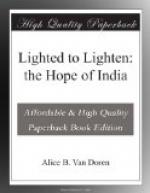“In conclusion, expressing the same idea in stronger words, it is to be noted that whether India shall maintain her self-government, when she receives it, depends on how far the women are ready to fulfill the obligations laid upon them. This is a great question and has to be decided by the educated women of India.”
[Illustration: In the Laboratory, Madras]
[Illustration: Tennis Champions with Cup AT WORK AND PLAY]
One Reformer and What She Achieved.
Of the wealth of human interest that lies hidden in the life-stories of the one hundred and ten students who make up the College, who has the insight to speak? Coming from homes Hindu or Christian, conservative or liberal, from the cosmopolitan atmosphere of the modern Indian city, or the far side of the jungle villages, one might find in their home histories, in their thoughts and ambitions and desires, a composite picture of the South Indian young womanhood of to-day. Countries as well as individuals pass through periods of adolescence, of stress and strain and the pains of growth, when the old is merging in the new. The student generation of India is passing through that phase to-day, and no one who fails to grasp that fact can hope to understand the psychology of the present day student.
In Pushpam’s story it is possible to see something of that clash of old and new, of that standing “between two worlds” that makes India’s life to-day adventurous—too adventurous at times for the comfort of the young discoverer.
Pushpam’s home was in the jungle—by which is meant not the luxuriant forests of your imagination, but the primitive country unbroken by the long ribbon of the railway, where traffic proceeds at the rate of the lumbering, bamboo-roofed bullock cart, and the unseemliness of Western haste is yet unknown. Twice a week the postbag comes in on the shoulders of the loping tappal runner. Otherwise news travels only through the wireless telegraphy of bazaar gossip. The village struggles out toward the irrigation tank and the white road, banyan-shaded, whose dusty length ties its life loosely to that of the town thirty miles off to the eastward. On the other side are palmyra-covered uplands, and then the Hills.
The Good News sometimes runs faster than railway and telegraph. Here it is so, for the village has been solidly Christian for fifty years. Its people are not outcastes, but substantial landowners, conservative in their indigenous ways, yet sending out their sons and daughters to school and college and professional life.
Of that village Pushpam’s father is the teacher-catechist, a gentle, white-haired man, who long ago set up his rule of benevolent autocracy, “for the good of the governed.”
“To this child God has given sense; he shall go to the high school in the town.” The catechist speaks with the conviction of a Scotch Dominie who has discovered a child “of parts,” and resistance on the part of the parent is vain. The Dominie’s own twelve are all children “of parts” and all have left the thatched schoolhouse for the education of the city.




